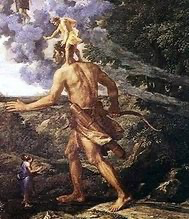Play
The Healing Powers of Holding Your Father’s Hand
The forever bond of father and child.
Posted June 19, 2022 Reviewed by Jessica Schrader
Key points
- Physical contact with fathers can be a significant developmental contribution to children’s emotional and social growth.
- Holding hands produces advantages over stress and pain and facilitates empathy.
- Symbolism in myth and art can focus on understanding fathers’ contributions to us.
Because of the nursery rhyme "Twinkle Twinkle, Little Star," my little son had taken to calling stars “up-aboves.” It’s one of his charms to point them out on a nighttime walk, riding on my shoulders. He believes that all people live to the age of 100, then we fly up there to live together. Someday when I go, he says that he won’t let me go alone. He’ll jump on my back whether I like it or not and ride up there with me.
It shouldn’t be lost on us that the innocent, authentic language of children—with which they boldly claim their experiences of the world as their own—contains a certain magic that reminds us of how separated we become as adults from the experience of the numinous.

This is perhaps the lesson of Orion, the hunter of ancient Greek myth, who had gone too far in his ambitions, crossed the line of respect and diplomacy with the other gods and goddesses to have Zeus punish him by ripping out his eyes. In desperation, he approached the blacksmith god, Hephaestus, and asked that he fashion him new eyes to replace the lost ones.
The blacksmith was firm in denying the request—it would directly disobey Zeus, and doing so wouldn’t work, anyway. He said that Orion was destined to walk all the way to the furthest, eastern regions of the world where the sun god, Helios, rises every morning. This illumination would reward his journey to change himself and his relations with others with “new eyes.”
How was Orion to walk such an impossible distance without eyes?
Hephaestus’ solution is that he would lend Orion one of his apprentices, a young boy, Cedalion. The boy would sit on his shoulders as he walked and could serve as his substitute sight until he could earn back his new eyes when morning breaks.
And so they began a long pilgrimage east.
Remembering to Hold Hands With a Son
We were about to cross a busy street in Chicago when I instinctively grasped my son’s little hand, at which he clutched mine tight. As I always do, I told him that he is my favorite person in the whole world. As we reached the other side, his grip softened until he ripped it away a moment later to jump to the curb.
I felt suddenly and profoundly sad, not knowing why until late that night. I thought back to the only time I recall my father ever holding my hand. At the same age as my son, a dog bit me. My father grasped my hand to lead me back to the dog—to find it could not hurt me with him present. Instead, I would rip my hand away and run, the thing that incited its reflex to bite in the first place.
He was a mathematician and airplane pilot who passed a long time ago. Decades later, when I fly and feel the jarring sense of turbulence, I make up for all the lost opportunities to hold my father’s hand and trust it. I close my eyes and imagine the feeling of my father’s large hand enveloping my own, which becomes a sense of peace and calm, confident that everything will be alright. I thank him, then we “talk,” making up for the lost time of him dying young.
Grossman et al. (2002) show that paternal gender socialization may be disproportionately influential to the maternal on child outcomes. Our connection to our fathers profoundly affects how our lives will unfold.
Our special place to continue a never-ending conversation continues long after my father’s passing. It only exists for us above 30,000 feet, where he was happiest as a pilot. It is a feeling of saudade—both sad that we didn’t hold hands nearly enough in life, yet enjoyable to still have a personal, tangible connection to a man who sacrificed so much of his own welfare for my security and happiness.
Andrew Briggs (2019) describes the “present father" in your life as the genesis of identity development and the ability to learn and discover the world around us via distinctions between the events, people, and their circumstances within it.
Allan Schore (2017) demonstrates that fathers play a fundamental role in regulating emotion, and “rough-and-tumble” play is especially useful to boys in learning to grow into adults who operate in the world within societal limits and under the guidance of societal rules. The most straightforward action with which such play begins and ends is the tender, soft moments of both initial touch and letting go that are felt in hands holding each other.
Remembering to Hold Hands With a Daughter
I would have another remembrance of a hand to hold in the form of a small picture. It is a black-and-white print of a small girl in the wind; her hand outstretched toward a vivid-red, heart-shaped balloon. It looked like the uncontrollable wind was taking away all the color of life itself, leaving her and her world colorless.
I burst into tears at the sight, not knowing why until moments later what was obvious.
We had once lost who we were certain was going to be a daughter. It felt as if I was suddenly looking at the outstretched hand I would never hold, who left before she could even emerge into the world.
I had no idea who Banksy was up to that point, nor that I was looking at his most famous painting, one which, like the artist, had shaken the art world through paradox—Miguel Pina e Cunha, et al. (2021). People around the world debate whether the balloon is lost innocence or whether she is chasing the balloon and is holding out hope to grasp it again, to come alive in a world of color.
We can all interpret it very personally, which is part of the genius of Banksy. Still, it begs anyone witness to it to grab the hand of the girl, and to hold it tight, whatever our personal connection to the piece may be.

Seeing Girl with Balloon reminded me of Michelangelo’s Creation of Adam in the Sistine Chapel. Outstretched hands between the terrestrial world and the numinous, which by touch, we create and are created. As if the Michelangelo is the response to the Banksy, the “hand of the father” is meant to grasp that of the girl once the balloon drifts beyond reach. It would only be then that “everything’s going to be alright” for her again, the ultimate mission of a father for a daughter.
Hand-Holding Lasts Forever
The research on hand-holding says that it lowers blood pressure, reduces pain in parallel with empathy, and synchronizes brain waves in correlation with the ability to accurately assess each other’s emotional states—Goldstein (2018).
If you close your eyes with empathy for someone you’ve lost too early, you are still holding hands, and it makes you the kind of person to make sure that everything will be alright for others. If you’ve lost your father, his generosity was real, and what you have become because of him is just as real and still growing by his influence.
You are still holding hands with him and can continue to do so until the day that you, too, fly to meet him in the “up-aboves.” For now, your connection is renewed any time you close your eyes and reach out your hand.
References
Jennifer S Mascaro, Kelly E Rentscher, et. al. (Jun 2017). “Child gender influences paternal behavior, language, and brain function”. Behavioral Neuroscience. 131(3), 262-273.
Karin Grossman, Klaus E. Grossmann, Elisabeth Fremmer-Bombik, Heinz Kindler, Hermann Scheuerer-Englisch, And Peter Zimmermann (July, 2002). “The Uniqueness of the Child–Father Attachment Relationship: Fathers’ Sensitive and Challenging Play as a Pivotal Variable in a 16-year Longitudinal Study”. Social Development. Vol 11, Issue 3, pp. 301-337.
Briggs, A (2019) [The Impact of Father Absence on Child Mental Health: Three Possible Outcomes], in Barry, JA et al. (2019). The Palgrave Handbook of Male Psychology and Mental Health. Wiley. Pp 69-72.
Pavel Goldstein, Irit Weissman-Fogel, Guillaume Dumas, and Simone G. Shamay-Tsoory
(February, 2018). “Brain-to-brain coupling during handholding is associated with pain reduction”. Proceedings of the National Academy of Sciences. 115 (11) E2528-E2537
Miguel Pina e Cunha, Stewart Clegg, Marco Berti, Arménio Rego, Ace V. Simpson (2021). “Fully Embracing the Paradoxical Condition: Banksy to Organization Theory”. Organizational Aesthetics 10(2): 50-67




